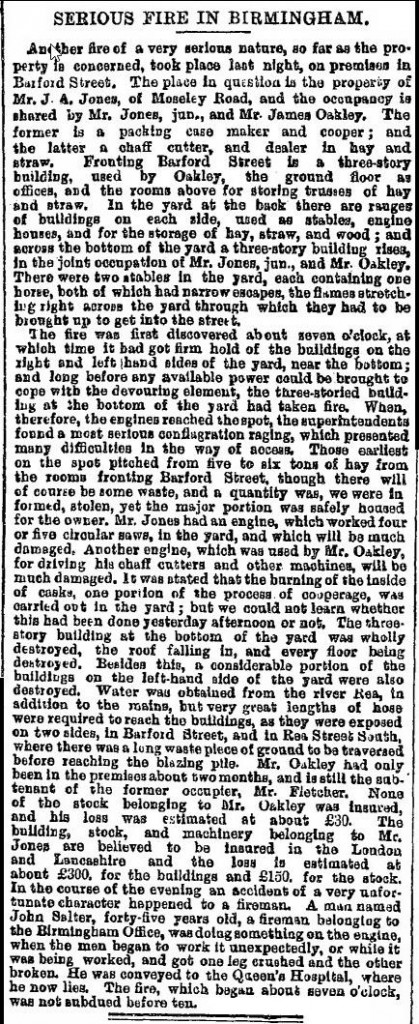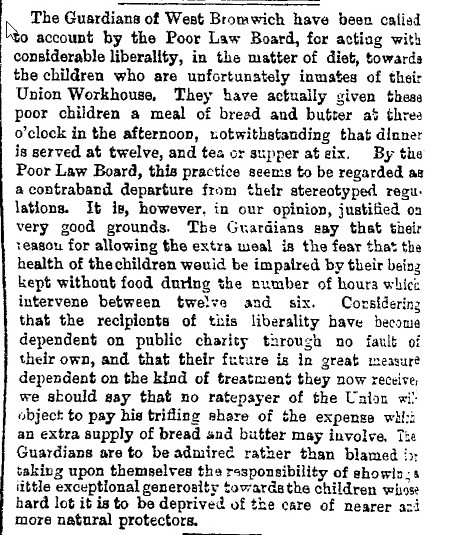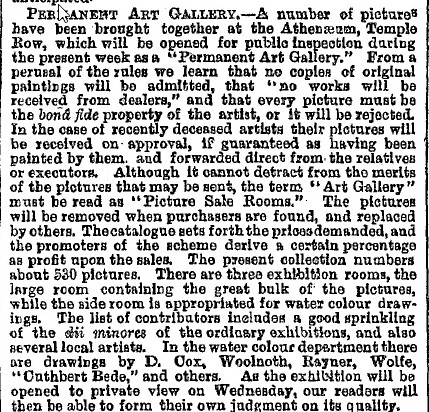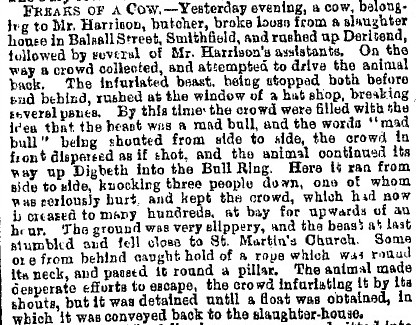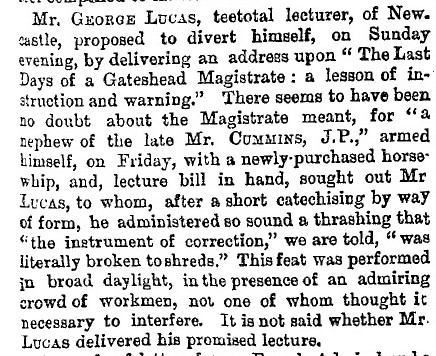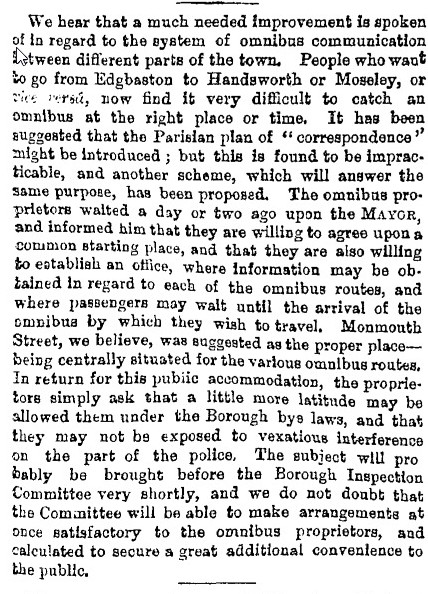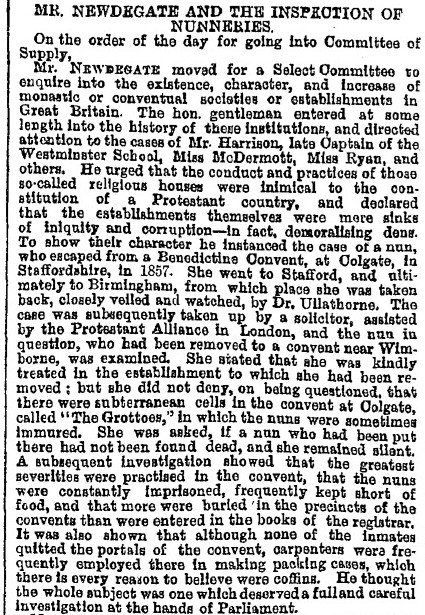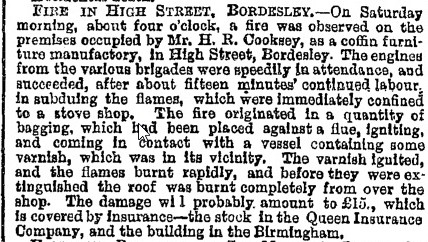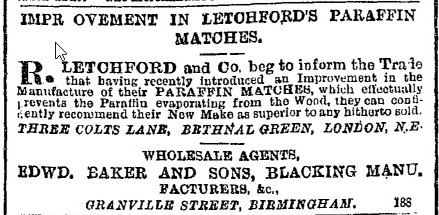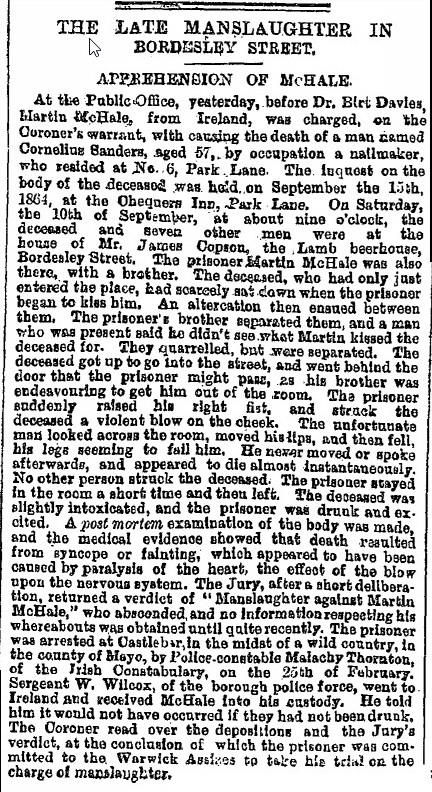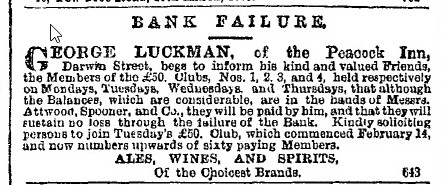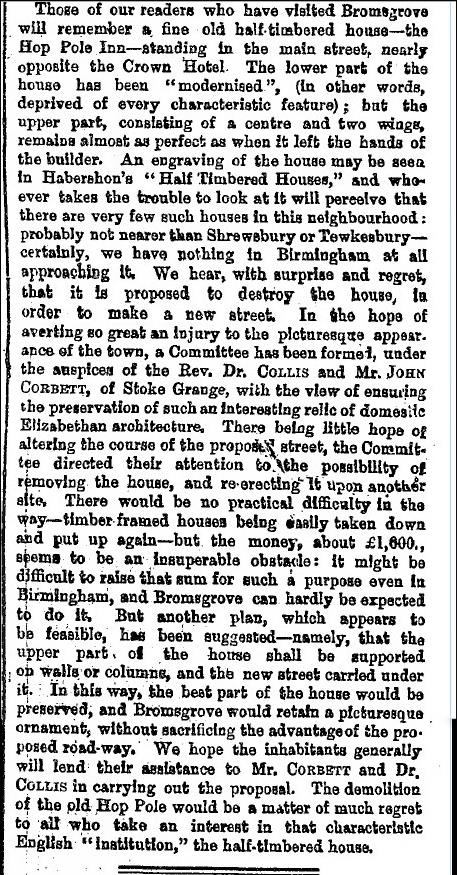-
Welcome to this forum . We are a worldwide group with a common interest in Birmingham and its history. While here, please follow a few simple rules. We ask that you respect other members, thank those who have helped you and please keep your contributions on-topic with the thread.
We do hope you enjoy your visit. BHF Admin Team
You are using an out of date browser. It may not display this or other websites correctly.
You should upgrade or use an alternative browser.
You should upgrade or use an alternative browser.
Newspapers : From Birmingham Post 150 years ago
- Thread starter mikejee
- Start date
16.2.1865
Factory owners responses in Birmingham were surprisingly favourable to proposed new Factory Act regulations concerning employment of children.
Chainmakers in Tipton were not as worker-friendly, with a lockout of any union members
A pub many here are familiar with was then for sale. This is the same Bottle & Glass which now resides at the Black Country Museum - one pub which will always have plenty of customers and not be turned into a strip club/ mosque/restaurant/ gay bar.

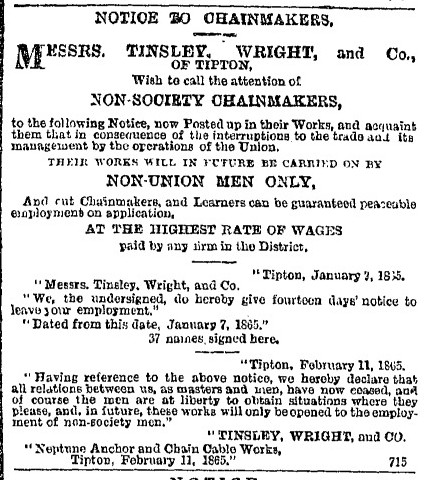

Factory owners responses in Birmingham were surprisingly favourable to proposed new Factory Act regulations concerning employment of children.
Chainmakers in Tipton were not as worker-friendly, with a lockout of any union members
A pub many here are familiar with was then for sale. This is the same Bottle & Glass which now resides at the Black Country Museum - one pub which will always have plenty of customers and not be turned into a strip club/ mosque/restaurant/ gay bar.



Good to see a hint of consideration for the health of the children and therefore their futures. Advanced thinking for the time. Viv.
paul stacey
master brummie
So 300 odd years, post the "English Reformation", Catholic institutions in side the United Kingdom, are still practising methods prohibited by Parliament and Rome, this includes, (zealous religious sacrificial murder).!!? The mind boggles.Paul
DavidGrain
master brummie
I saw some "vexatious interference" recently in Oldbury town centre when I saw a Civil Enforcement Officer as I believe traffic wardens are now called ticketing a bus in a bus layby. He also took a photo to show what he had done!
paul stacey
master brummie
We have all heard the stories of Nuns, "being walled up", or beaten, or starved, for some minor transition or other but the mid 19th C, a bit far fetched, and according to the noted reporter, it was on an industrial scale.Paul
Was wondering why Edward Baker & Sons, the blacking manufacturer, was an agent for paraffin matches. Maybe they supplied these alongside blacking for the old lead cooking ranges? I remember my gandmother's lead range which was always polished and spotless. Viv.
9.3.1865
I wonder what his wonderous scheme was. However I was intrigued by his mention of his father,William James, and apparently, though I had not come across him, he does seem to be an early pioneer in railways, though none of his schemes came properly to fruition.
P.S. Have now found that his scheme probably involved steam driven "horseless carriages" on roads

I wonder what his wonderous scheme was. However I was intrigued by his mention of his father,William James, and apparently, though I had not come across him, he does seem to be an early pioneer in railways, though none of his schemes came properly to fruition.
P.S. Have now found that his scheme probably involved steam driven "horseless carriages" on roads

Radiorails
master brummie
Two links: the first to father and second to son - the subject of some posts in this thread.
https://www.gracesguide.co.uk/William_James
https://www.gracesguide.co.uk/William_Henry_James
https://www.gracesguide.co.uk/William_James
https://www.gracesguide.co.uk/William_Henry_James
13.3.1865
Thank goodness for modern taxi meters, assuming they are working properly. Mind you if there were fixed fares for each destination then the taxi couldn't go round the houses to get a higher fare.
I know licencees often had another occupation (often of necessity) but think it would be a bit odourous to drink in a pub with a pig farm in the yard.
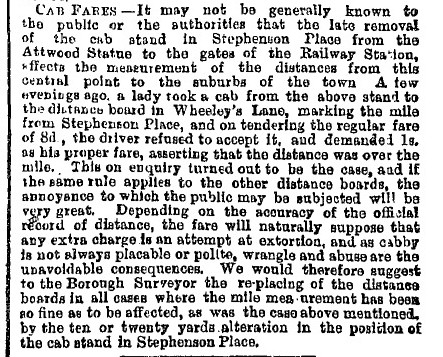
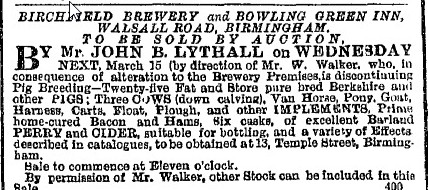
Thank goodness for modern taxi meters, assuming they are working properly. Mind you if there were fixed fares for each destination then the taxi couldn't go round the houses to get a higher fare.
I know licencees often had another occupation (often of necessity) but think it would be a bit odourous to drink in a pub with a pig farm in the yard.


The Hop Pole Inn – Bromsgrove.
I researched the above over the years, first it appeared when I did the family history for my cousins wife, her ancestor was John Irish below. His descendants are still in Bromsgrove. Second was for a friend of mine in Birmingham, his family with the surname Tilt was originally from Bromsgrove, his ancestors were the builders who moved the inn to the present site in Birmingham Road.
“The Hop Pole Inn dating from 1572 one of the finest specimens of half timbered domestic styled buildings in the district, was taken down on the formation of the road leading to the Railway Station, but very successful relocated and restored in 1867, by the Worcester City & County Banking Company (now Lloyds Bank Ltd), under the Superintendence of W. J. Hopkins esq. Architect of Worcester and their branch in Bromsgrove. The principal business rooms occupies the height of two of the original lower stories and has a rich and lofty semi circular bay window, filled with oak tracery, projecting at the end facing the main street. A commodious house for the manager has been added to, and designed so as to harmonize with, the picturesque old house, the general result being a singular yet beautiful structure well adapted both to the purpose and to the site.”
“At the north of the town, on the east side of the Birmingham road, is the modern church of All Saints. The building occupied by Lloyds Bank at the corner of Worcester Street and the road leading to the railway station is constructed out of the materials of the Hop Pole Inn, a 16th-century structure of half timber taken down about 1870 and re-erected. The design appears to have been much altered in the process of re-erection.”
The above information indicates that most of the materials from the original building which was located on the east side of the High Street were incorporated into what is now Lloyds Bank. Although the new location is not mentioned we can assume that became the present location at 78 Birmingham Road.
Licensees of the Hop Pole Inn. High Street 1572 to late 1850s. Birmingham Road 1867 - present.
In the 1842 London Gazette, the Hop Pole is listed as the Inspectors Office for the Corn Returns.
· ? To 1839 John Irish, born Bromsgrove 1785.
(References Pigots Directory 1828 – 29, Creditors Notice London Gazette, 1837
and Monumental Inscription St. John’s churchyard, John Irish late of the
Hop Pole Inn died 27 Aug 1839 age 54).
· 1840 to early 1850s William Ackrill, born Hartlebury about 1811.
(References 1841 & 1851 census and Post Office Directory 1850).
· After 1851 to 1856 William Knight, born Droitwich 1813. See Bankruptcy Notice September 1856.
(William Knight & Wife Jane, born 1811 Stoke Prior, ran the Navigation Inn, Stoke Prior 1841/51.
At the Fountain Inn, Stone St. Oldbury, 1861)
No trace of Hop Pole on 1861 census, assumed work on relocation had begun.
· 1867 to 1877 Benjamin Tilt 1817 – 1877 Bromsgrove.
(Reference 1871 census and research into family. Benjamin and his family were also Builders, the question is did they re-erect the Hop Pole, they had lived in Birmingham Road certainly since 1841 and probably well before)?
· 1877 to late 1890s Joseph Tilt, son of above 1846 – 1914 Bromsgrove.
(Reference 1881, 1891 census and various directories).
· 1901 census Albert Forrester, born Stirchley about 1873.
· 1911 census Vernon James WARD & Mary Jane Ward nee TILT
Clarkie
I researched the above over the years, first it appeared when I did the family history for my cousins wife, her ancestor was John Irish below. His descendants are still in Bromsgrove. Second was for a friend of mine in Birmingham, his family with the surname Tilt was originally from Bromsgrove, his ancestors were the builders who moved the inn to the present site in Birmingham Road.
“The Hop Pole Inn dating from 1572 one of the finest specimens of half timbered domestic styled buildings in the district, was taken down on the formation of the road leading to the Railway Station, but very successful relocated and restored in 1867, by the Worcester City & County Banking Company (now Lloyds Bank Ltd), under the Superintendence of W. J. Hopkins esq. Architect of Worcester and their branch in Bromsgrove. The principal business rooms occupies the height of two of the original lower stories and has a rich and lofty semi circular bay window, filled with oak tracery, projecting at the end facing the main street. A commodious house for the manager has been added to, and designed so as to harmonize with, the picturesque old house, the general result being a singular yet beautiful structure well adapted both to the purpose and to the site.”
“At the north of the town, on the east side of the Birmingham road, is the modern church of All Saints. The building occupied by Lloyds Bank at the corner of Worcester Street and the road leading to the railway station is constructed out of the materials of the Hop Pole Inn, a 16th-century structure of half timber taken down about 1870 and re-erected. The design appears to have been much altered in the process of re-erection.”
The above information indicates that most of the materials from the original building which was located on the east side of the High Street were incorporated into what is now Lloyds Bank. Although the new location is not mentioned we can assume that became the present location at 78 Birmingham Road.
Licensees of the Hop Pole Inn. High Street 1572 to late 1850s. Birmingham Road 1867 - present.
In the 1842 London Gazette, the Hop Pole is listed as the Inspectors Office for the Corn Returns.
· ? To 1839 John Irish, born Bromsgrove 1785.
(References Pigots Directory 1828 – 29, Creditors Notice London Gazette, 1837
and Monumental Inscription St. John’s churchyard, John Irish late of the
Hop Pole Inn died 27 Aug 1839 age 54).
· 1840 to early 1850s William Ackrill, born Hartlebury about 1811.
(References 1841 & 1851 census and Post Office Directory 1850).
· After 1851 to 1856 William Knight, born Droitwich 1813. See Bankruptcy Notice September 1856.
(William Knight & Wife Jane, born 1811 Stoke Prior, ran the Navigation Inn, Stoke Prior 1841/51.
At the Fountain Inn, Stone St. Oldbury, 1861)
No trace of Hop Pole on 1861 census, assumed work on relocation had begun.
· 1867 to 1877 Benjamin Tilt 1817 – 1877 Bromsgrove.
(Reference 1871 census and research into family. Benjamin and his family were also Builders, the question is did they re-erect the Hop Pole, they had lived in Birmingham Road certainly since 1841 and probably well before)?
· 1877 to late 1890s Joseph Tilt, son of above 1846 – 1914 Bromsgrove.
(Reference 1881, 1891 census and various directories).
· 1901 census Albert Forrester, born Stirchley about 1873.
· 1911 census Vernon James WARD & Mary Jane Ward nee TILT
Clarkie
paul stacey
master brummie
Very interesting, positive read, "Clarkie", thanks for posting.Paul
Harbornite76
master brummie
Thanks for sharing this information, good to see that some people cared about old buildings back then.

